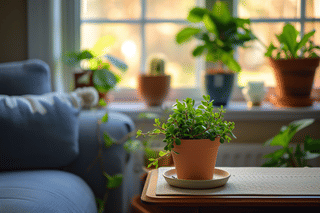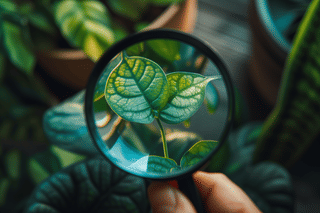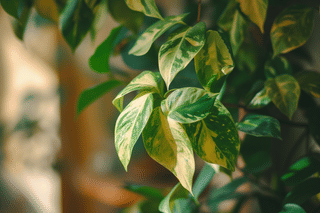Why you should quarantine any new houseplants
Discover the importance of quarantining new houseplants with this comprehensive guide. Learn how a simple quarantine period can prevent pest infestations and diseases, ensuring the health and longevity of your indoor garden. Your plants will thank you!
Are you excited about buying new houseplants?! Excellent! Before you go overboard and fill every gap with a new plant, let's look at a very important step many plant owners tend to skip when buying new plants: quarantining them.
In this plant care guide, we're going to look at a few reasons why you should quarantine your houseplants and how you can do this. These are the topics we're going to look at:
Let's learn why we should quarantine our new houseplants and how it works. Let's get started!
Why should you quarantine your houseplants?
Quarantining new houseplants is a really important step that many plant enthusiasts often forget about. When you bring a new plant home, it might come with pests or diseases that could harm your other plants. These threats might not be obvious, but they can be damaging if you don't take care of them quickly.
You know your plants and you know if they're dealing with issues, but you don't know this about your new plants. Sure, they might look great, but have you carefully checked the plant with a magnifier in the plant shop? Probably not, and that's fine. That's why you should quarantine your new houseplants.
By keeping your new plants away from your collection, you can take 1-2 weeks to make sure the new plant is healthy, is not suffering from any pests, and doesn't suffer from a disease. This way, you can protect the overall health of all of your houseplants.
Common misconceptions about plant quarantines
Now that we know why you should quarantine your new houseplants, let's have a look at some of the misconceptions you might have heard. Let's debunk some of these common myths and misconceptions:
Myth 1: Quarantine is only for visibly sick plants
Quarantine is especially important for visibly sick plants, but pests or diseases may not always be visible right away.
Myth 2: A quick inspection is enough
A quick look over your plant can help spot the biggest issues, but many pests and diseases are not easily visible to the naked eye. This is why you should stick to a thorough inspection and a 1 to 2-week quarantine period. This time will help to discover any problems.
Myth 3: Isolation is harmful to the plant
Some might worry that isolation could stress the plant. It's the other way around: it provides a buffer zone for the plant to adjust to its new environment, and any signs of stress are more likely due to changes in care routine or environment. More on this later.
Myth 4: All pests and diseases can be treated
While many pests and diseases can be treated, some infestations or diseases are more difficult. In the worst-case scenario, it's better to dispose of a heavily infested or diseased plant to protect the health of your other plants. I've personally never had this happen, but sometimes nothing seems to work and your plant is a lost cause.
Myth 5: Quarantine guarantees a pest-free plant
Even after a successful quarantine period, there's always a small chance that pests or diseases might appear later on. Regular check-ups still stay important after the quarantine.
I hope these myths helped to paint a picture of why quarantining your new plants is so important. Now let's have a look at how you can properly quarantine your plants.
The steps to take to properly quarantine your houseplants
Quarantining houseplants is pretty simple. When you quarantine new houseplants, you're just keeping them away from your other plants. Sometimes, it can be as easy as placing them on the other side of the room. No need for a whole separate room as your quarantine space. Just use separate shelves, a different windowsill, or even a different room if you have the space.
It's important to keep your new plant in isolation for at least 1-2 weeks. During this time, make sure to carefully inspect the plant for any signs of pests or diseases. Use a magnifier and take your time examining every leaf and stem.
If you do find any pests or diseases, treat the plant accordingly before adding it to your collection. If everything checks out and the new plant is healthy, then you can place it with your other plants and you've got a new member of your plant family.
How do you check your plant for pests and diseases?
So quarantining your plant is quite easy. During the quarantine you'll have to check your plants for pests and diseases, but how do you do this?
Here are some simple tips to check if your new houseplant has issues:
- Use a magnifier to closely inspect the plant. Look for any tiny bugs, eggs, webs, or holes in the leaves and stems.
- You can also gently shake the plant over a white sheet of paper to see if any pests fall out.
- Check the soil for any signs of fungus or mold growth. You can usually see discoloration in the soil or it'll smell funky.
- Pay attention to any changes in the plant's appearance, such as discoloration, wilting, or deformities. This could be a sign of a pest or disease.
By carefully checking your new houseplants during quarantine, you can catch and treat any potential issues before they spread to your other plants.
New houseplants and shock
If you've taken care of houseplants for a while, you might know that some plants get stressed when you move them or change their care routine. This could also happen to new houseplants. They're in a new environment after you bring them home from a store.
Stressed plants could show signs of trouble, especially discoloration and wilting. If you've already checked your plant for pests and diseases and found no issues, this might be a little confusing. If you've made sure your plant is fine, but you still see these symptoms, the best thing you can do is"nothing".
Your new plant could be in shock, especially if it's cold or windy outside. If it's in shock, it'll need some time to adapt to your home and recover. The best thing you can do during this time is to take care of it like normal: water it on time, fertilize it if it's the growing season, and give it plenty of indirect sunlight. Other than that, don't move your plant, and try not to handle it too much.
These symptoms should usually disappear after 1-2 weeks. Once your plant is no longer showing any signs of stress/shock, you can slowly move it to its final spot. Keep in mind, this move could also cause stress, so try to make sure you're prepared for this or the new spot is very similar to the previous spot.
What happens if the new houseplant "fails" quarantine?
The goal of quarantining your plants is to make sure it doesn't spread any potential pests and diseases to your other plants. So as long as you keep the plant away from the rest of your plant collection, you don't have to worry about quarantine. But what happens if your new plant turns out to have pests or diseases?
If your new plant has problems, you'll need to address these like you have to for your other plants as well. There is just one difference: Plants in your regular collection need to be isolated from the rest of your collection when you find the problems and your new plants are already isolated.
After you find pests or diseases, you'll treat them like any other plant with problems. Only after the pests are gone should you move the plant back to your collection.
Conclusion
In conclusion, the process of quarantining new houseplants is an important part of maintaining healthy indoor plants. It's a simple, yet effective way to detect and treat any potential pests or diseases before they can spread to the rest of your plant collection. By taking just a few weeks to observe and care for your new plants in isolation, you are not only making sure they're healthy, but you're also helping the rest of your plants to stay safe.
Thank you for reading this post! I hope it helps you to keep your plants healthy and beautiful! If you're looking for more guides on specific plants, you can always request a plant guide to get a guide for the plant you have trouble with.
Test your plant care knowledge
Quiz completed!
Want to learn more? Sign up for my newsletter to receive free tips in your inbox!
Sign up now!








